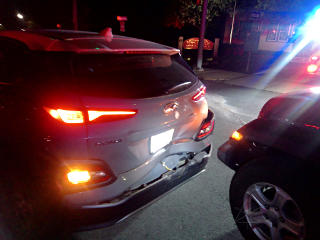
|
First, read this forum post:
https://www.insideevsforum.com/community/index.php?threads/butthurt.11017/ then come back to this page. This is the somewhat agonizing story of "Kona #2". |
[Images link to larger versions]

|
This is the picture with the forum post, which you don't see fullsize unless you're logged in. This was basically right after the chain impact. |
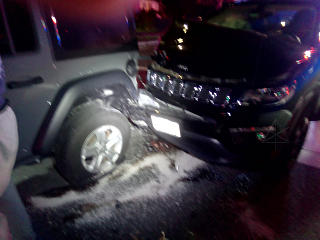
|
The Jeeps suffered significant damage, and are probably totaled given how
stupidly expensive it is to fix auto damage these days.
The phone camera does really badly in low light, and my flashlight was
only a little help.
[Causative individual 100% at fault, just so she's findable on the internet
and held accountable for so casually fucking up the lives of others:
|
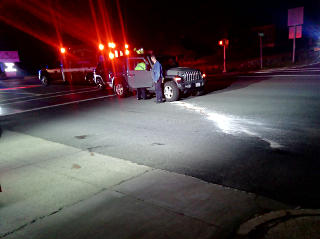
|
After I moved aside, the two Jeeps couldn't be moved yet. They had thrown absorbent litter along the path of fluids leaking from the crushed engine bay of Chelsee's Jeep. |
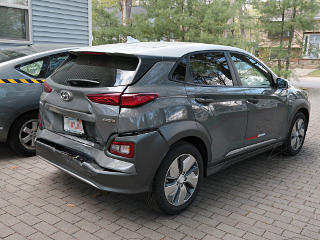
|
Taking a better look the next morning... |
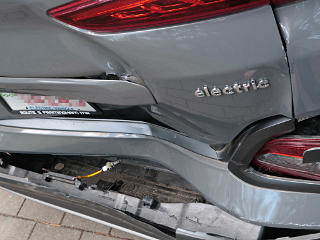
|
The hatch and bodywork under the opening got pushed pretty far in, but fortunately there's a lot of nonessential "crush space" in the way the rear of the Kona's body is constructed. |
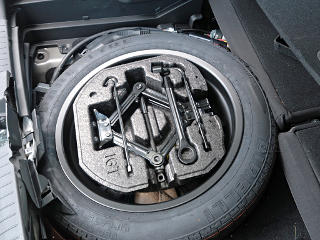
|
My custom spare tire was compressed a bit but not damaged, and I managed to extract it and the stuff underneath. |
[Newer/updated part of this page follows]
|
A guy from the insurance company came by to collect appraisal data,
and took much the same set of pictures.
The formal appraisal was emailed a while later, and ballparked the damange
at something over $7000.
With less than 20,000 miles on a $40k-ish car, everyone agreed that it wasn't
enough to total it, and I was sent a list of the insurance company's
"recommended" body shops.
Another pain in the ass, since it was up to me to call around and find one
that could tackle this.
Arrangements were made, and one morning I drove the car down to said body
shop to drop it off and pick up a rental car to use over the repair time.
I had no inkling yet that it would be the last time I would drive that particular Kona. Some of the story is also detailed in the referenced thread, but here's more of it in pictures. Once the body shop got enough of the interior trim pulled out, another appraisal was done, and they found that some of the inner layer of body metal, that is the special "high-tensile" steel that forms the passenger cage, was a bit bent here and there too. Apparently you can't just pull that back out, even in the rear part of the car, and call it factory-spec good -- it all has to be *new* material to fully restore the car. The body shop researched a little more, including downloading and printing parts of the the body-repair guide from Hyundai, and determined that basically, the car would need an entire new ass -- including a lot of welding and extensive rework at the roofline. This suddenly brought the likely repair cost to around $25 grand or more. So the insurance company decided that it was a total write-off, and transferred the entire claim to their "total loss" department to handle the rest of the way. Fuck. Not what I expected. Now I had to completely change direction; I was already receiving pressure to go get my personal effects out of the car at the body shop and "release" it to get hauled away by a salvage outfit. This required a lot of fast planning, as I had quite a few extra parts vested in the car, some at a fairly deep level like wired into the harness. It didn't take long for the possibility of getting another Kona to replace this to reach prominence in my thoughts, as I not only liked the car at its acquisition, it had grown on me even more over my ownership to date. Well, except for all of the 2019 battery packs being under recent recall for fire hazard -- that was a whole separate nightmare around the owner community, mostly because Hyundai was completely bungling the "remedy". So perhaps this dark cloud on my automotive path had a silver lining: the newer 2021 Konas were *not* under recall, as Hyundai had started buying safer cells from a different manufacturing line, so swapping to a car two model-years later would get me a new and safer pack and possible drivetrain improvements, effectively a fresh start on the whole EV-ownership thing. The first 7000+ or so miles had been fun, but in a way, even though it wasn't the actual situation here, it almost felt like I'd only been leasing the car for a couple of years and now it was time to buy in for real. |
|
With the intervening hassle of completing the disposal and having to go
car-shopping again, it was good that the Prius was still on the road.
It had not run much over the height of the pandemic, and needed a good bit
of cleanout inside including yet another rodent-bolus in the heating
system and actual *mold* on my seatbelt.
But all that was minor; I still needed to get around in something, and
there actually wasn't much point in having the rental if I had another
car available. The problem was delivery logistics -- how to travel back
and forth when picking up or dropping off vehicles, without drawing heavily
on favors from friends.
An interesting solution to that was already in the works --
in parallel with this whole Kona mess, my next sideline subchapter in EV
ownership was already beginning.
I ordered an e-scooter. You know, one of those little stand-up death machines that are all over cities now as for-hire pools. Higher-end models are available for personal ownership and some of the specs seemed fairly favorable, with decent pneumatic tires and full suspensions and respectable electric ranges. I plunked in an order and expected to wait quite a while, but the actual item showed up surprisingly quickly given what the source company had been saying about their supply lines. Its first real mission was to get me back home after dropping the rental back at the Hertz office, only three days after picking it up. Even if insurance was paying for it, why waste the money if I didn't need it? Besides, it was a Buick, and only Buick can take something in a smallish, supposedly agile SUV/crossover form factor and make its driving feel like like a big ol' wallowing land-yacht sedan from the seventies. Not that I was doing the insurance company any favors. The next thing to talk about was my settlement for the officially totaled car, and of course they tried to lowball it on me. Fuck you, MAPFRE. I did my own research at Blue Book and NADA, and knew about what they *should* be giving me. I guess they just do this to everybody as a matter of routine, hoping to get away with it. Sleazebags. Try to be a *little* more honorable than Liberty Mutual, huh? They came up with sketchy "research" of equivalent cars, some being offered two or three states away and of questionable similarity at all. The kicker that I made very clear to them was this: I could not walk onto a lot and buy a commensurate *used* 2019 Kona, period, due to the outstanding and so far irremediable battery recall on all of them. I called the dealers listing the items in the "report" and at least two of them confirmed that no, those cars were under "stop-sale" and they could not legally be sold at all. My only choice was to go up in model years far enough to get clear of that issue, which, conveniently, a *new* 2021 model Kona would qualify for. In response to my vigorous pushback, the insurance people "sent the claim over to management", and magically pulled an extra $7000 or more out of their ass that they simply could have offered up front. Still not ideal, but much more in line with my need to buy new again; I took the money and ran with it. My efforts in disproving the bullshit from the opposing insurance company had probably helped too. Hyundai's website is actually pretty good with regard to car-shopping, and once you get the site to work in the first place, shows actual per-dealer inventories fairly accurately. It didn't take long to find new "Snowcap stock", conveniently allocated to a dealer in Arlington, and as soon as I told them "I am ready to hand you my plates and a fat check", they were ready to sell. Semi-long story short -- one morning a week or so later, I was driving home in a shiny new exact replica of the car I had just lost, same trim level and paint scheme and everything. With the scooter that got me to the pickup stashed in the back. And the first Jeep to pull up behind me at a light was utterly terrifying. |
| It took about four days to get most of my hacks and setup back into the new car, with several other improvements and optimizations in the process. The weather was pretty miserable for some of that, hot and humid; I could not do any taping in the first couple of days because adhesion would have been poor to nonexistent. I could solder in the harness taps for the yuppie button, but didn't want to tape them up until more favorable conditions so they just sat exposed for a while. That's why tap points get offset along the length of a harness section, so they can't touch each other regardless. Fortunately, things dried out a couple of days later and I could finish up. |
_H* 210508, updated 210829